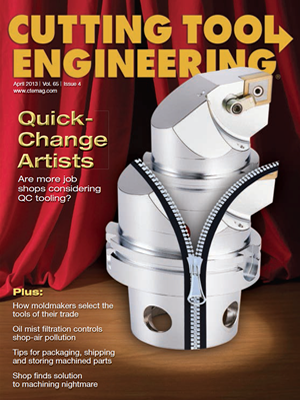Anybody with half a brain can immediately see the usefulness of computer-controlled equipment. The ability of a machine to telescope the work processes so they run in parallel instead of series can turn a single machinist into a one-person army. Think of it this way: A manual machinist does 1 man-day’s worth of work in 1 day, right? What if he could do 4 or 6 man-days of work in that same day?
CNC machines should be considered new and faster manufacturing tools, allowing a company to be more competitive or to increase its profit. They should not be thought of as machines that displace or make manual machine operators obsolete. It’s just technology!
I tell people I don’t really want to be on the cutting edge of technology, but I sure want to be riding on the blade. I was fascinated by CNC machines and their ability to do the tasks they do with such simple-looking instructions. At the time, it was all secret code I didn’t understand. For many machinists, the learning curve is steep, especially adding the complexity of using desktop computers, which perform a large part of the programming duties.
A few words of advice: Don’t go the way of the Wisconsin ice cutters. Most experienced manual machinists already know all the hard stuff, such as determining speeds and feeds and how to hold workpieces. Although most computer jockeys can figure out the controls on a modern CNC machine pretty quickly, it takes them 10 years to figure out how to hold tools and workpieces and then which tool performs what task. So hang in there, taking small, steady steps. By all means, take advantage of these machines.
One challenge I found difficult when learning to run CNC equipment was there was absolutely no sense of feel. Manual machinists develop an accurate sense of feel for something, such as how hard they can push a tool and how deep a cut they can take with a particular setup. This sense of feel has no place with automatic equipment. I had to learn the actual “numbers” for speeds and feeds when programming CNC machines.
The current crop of CNC machinery is so blindingly fast, it’s frightening. For most jobs, you cannot even approach the maximum available feed rates for the equipment. The machining world is waiting for the cutting tool industry to catch up with the machine tool builders because the cutting tools are the gating factors for achieving the highest metal- removal rate.
My experience with CNC machines is in the job shop environment, where the tips and tricks I developed are related to highly varied work and many different workpiece materials.
• Try to reduce cycle times for multiple or long-run parts, but never at the expense of consistency or predictability. A machinist can do much more productive and profitable work than babysit a temperamental process.
• Work on fixturing and part changing to reduce button-to-button time. This should be the actual measure of a single cycle. If you’re just keeping track of how long the machine takes, you’re in for a big surprise. On the same note, when you’re quoting this type of work, be sure to consider all the factors—not just the programmed cycle time.
• Add more comments in the program than you think you need. Memory is not as much of a problem as it used to be. Good programming practice includes comments and specifics about tooling and setup resident in the program.
• Try to program in a nonspecific machine format. If possible, your programs should be able to run in any equivalently equipped machine. The machine-specific information comes out in the post-processor.
• Programs that have actually been run and edited at the control are the Holy Grail. Programs downloaded from the machine control should be identified specifically in your program inventory. Regardless of how your shop keeps track of programs, there should be a simple way of identifying programs that have been run successfully. I add the suffix DL for download when saving a program downloaded from the machine control.
• Review the model or electronic information carefully when quoting. There are many ways the time you allotted for file conversion or importing can get screwed up. CAM systems work flawlessly on perfect models. Most of the time, the only place to get perfect models is at the machine tool shows where they demonstrate the CAM software. Part designers find new ways on a daily basis to make sure the work of the machine shop is never boring.
• Never forget that at some point in the completion of the job the actual part should be compared to the original, unmolested, electronic information received from the customer when you started. After all the electronic file conversions, model surface cleanup, hole blanking, surface extending and other steps done to a customer’s model in a CAM system to get it cut, sometimes it will come back and bite you. Go back to the original source.
• If possible, build your programs in such a way that a complete part comes off the machine. There is nothing more annoying that having to set up again because the part did not pass the first-article inspection and all your extra spare parts were consumed in setting up the other operations. Parts move and dimensions drift as more material is removed. If you can get a complete part or parts in hand with each cycle, you are doing well. CTE
About the Author: Tom Lipton is a career metalworker who has worked at various job shops that produce parts for the consumer product development, laboratory equipment, medical services and custom machinery design industries. He has received six U.S. patents and lives in Alamo, Calif. Lipton’s column is adapted from information in his book “Metalworking Sink or Swim: Tips and Tricks for Machinists, Welders, and Fabricators,” published by Industrial Press Inc., New York. The publisher can be reached by calling (888) 528-7852 or visiting www.industrialpress.com. By indicating the code CTE-2013 when ordering, CTE readers will receive a 20 percent discount off the book’s list price of $44.95.
Related Glossary Terms
- boring
boring
Enlarging a hole that already has been drilled or cored. Generally, it is an operation of truing the previously drilled hole with a single-point, lathe-type tool. Boring is essentially internal turning, in that usually a single-point cutting tool forms the internal shape. Some tools are available with two cutting edges to balance cutting forces.
- computer numerical control ( CNC)
computer numerical control ( CNC)
Microprocessor-based controller dedicated to a machine tool that permits the creation or modification of parts. Programmed numerical control activates the machine’s servos and spindle drives and controls the various machining operations. See DNC, direct numerical control; NC, numerical control.
- computer-aided manufacturing ( CAM)
computer-aided manufacturing ( CAM)
Use of computers to control machining and manufacturing processes.
- feed
feed
Rate of change of position of the tool as a whole, relative to the workpiece while cutting.
- parallel
parallel
Strip or block of precision-ground stock used to elevate a workpiece, while keeping it parallel to the worktable, to prevent cutter/table contact.


